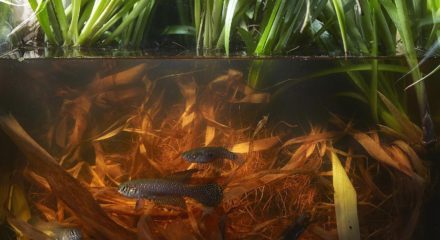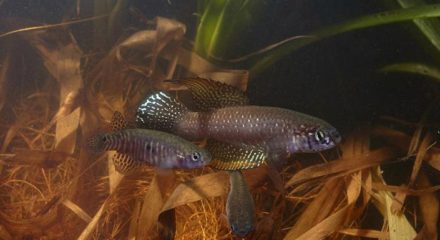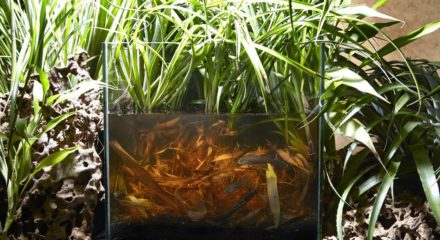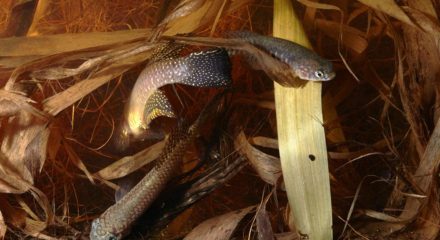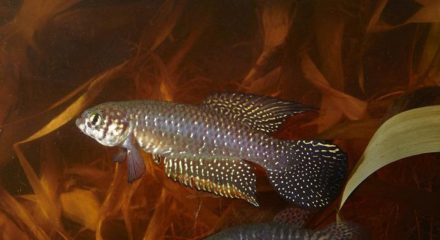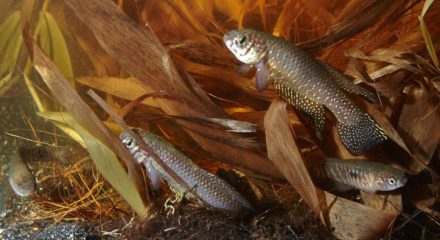Dry pond, Laguna de Marica, Rio de Janeiro, Brazil
32nd place in Biotope Aquarium Design Contest 2016
![]() Russia. Svetlana Kirillova
Russia. Svetlana Kirillova
Aquarium Volume: 30 L
Fish and invertebrates: Nematolebias papiliferus Inoa
Plants list: Reineckea sp., Billbergia sp.
Biotope description: This aquarium has been created based on small and ephemeral pond in the Brazilian pampas, habitat of Nematolebias papiliferus Inoa. This species is related to seasonal killifish. This fish in nature is short-lived, only during the wet season, when rainwater fills the puddles, ditches and grassy lowlands, and when they dry, it dies. And in some parts dry season happens twice a year – in the winter, usually from July to August, and in the summer, usually from February to March. Such unusual conditions of existence led to the fact that these fishes develop interesting features of biology and unusual life cycle. In temporary drought pond disappears and fish put eggs in damp soil, the former bottom. Eggs remain viable for a long time (in nature for several months, and in artificial conditions more than a year). The egg is covered with sand and dust. Thus, the cocoon protects it from drying and withstand heavy external loads. The eggs wait until the next rainy season. Moreover, eggs do not begin to develop without diapause, so that even when the fish is in aquarium, it is necessary to simulate the drought period. Another feature of these fish is rapid growth and sexual maturation. Fry emerge from the egg without the yolk, immediately begin to swim and feed actively. Fry grows quickly and to one and a half months, as a rule, are ready to breed. In the wild, they feed on small crustaceans, mosquito larvae (it is believed that the killifish help eliminate the number of mosquitos), insects fallen on the surface of the water, fry of other fish. These fishes spawn are very actively. The substrate for spawning of fish species in the aquarium is boiled peat. Fishes “dive” into it, completely disappearing from view. Due to the peculiarities of breeding these fishes are quite rare in pet shops and kept mainly by amateur enthusiasts, interested in this group of fish. To simulate grass vegetation Reineckea sp. and Billbergia sp. were used, placed in the tank at the time of taking photos.
Fish and invertebrates: Nematolebias papiliferus Inoa
Plants list: Reineckea sp., Billbergia sp.
Biotope description: This aquarium has been created based on small and ephemeral pond in the Brazilian pampas, habitat of Nematolebias papiliferus Inoa. This species is related to seasonal killifish. This fish in nature is short-lived, only during the wet season, when rainwater fills the puddles, ditches and grassy lowlands, and when they dry, it dies. And in some parts dry season happens twice a year – in the winter, usually from July to August, and in the summer, usually from February to March. Such unusual conditions of existence led to the fact that these fishes develop interesting features of biology and unusual life cycle. In temporary drought pond disappears and fish put eggs in damp soil, the former bottom. Eggs remain viable for a long time (in nature for several months, and in artificial conditions more than a year). The egg is covered with sand and dust. Thus, the cocoon protects it from drying and withstand heavy external loads. The eggs wait until the next rainy season. Moreover, eggs do not begin to develop without diapause, so that even when the fish is in aquarium, it is necessary to simulate the drought period. Another feature of these fish is rapid growth and sexual maturation. Fry emerge from the egg without the yolk, immediately begin to swim and feed actively. Fry grows quickly and to one and a half months, as a rule, are ready to breed. In the wild, they feed on small crustaceans, mosquito larvae (it is believed that the killifish help eliminate the number of mosquitos), insects fallen on the surface of the water, fry of other fish. These fishes spawn are very actively. The substrate for spawning of fish species in the aquarium is boiled peat. Fishes “dive” into it, completely disappearing from view. Due to the peculiarities of breeding these fishes are quite rare in pet shops and kept mainly by amateur enthusiasts, interested in this group of fish. To simulate grass vegetation Reineckea sp. and Billbergia sp. were used, placed in the tank at the time of taking photos.
Photo Gallery
Comments of the members of the jury of Biotope Aquarium Design Contest 2016

Interesting fish species, adapted to survive and prolong the species even when puddles dries out. It takes more effort to keep Killis, annual killfish are hard to find in regular pet stores and ordering peat bags with eggs over the internet is not for everyone. I awarded bonus points for biotope with rare fish.

I love this tank. It looks like the camera is underwater in the wild.

Very natural looking both the inside and the outside of the aquarium, and very interesting and rare fish. However, this tank is too small to keep the conditions steady for a longer time, especially with such high amount of dead plant matter.
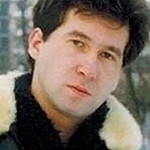
Despite the fact that in this aquarium there is only one species of fish, realistic picture is not questioned. I believe that this entry deserves a higher place.

